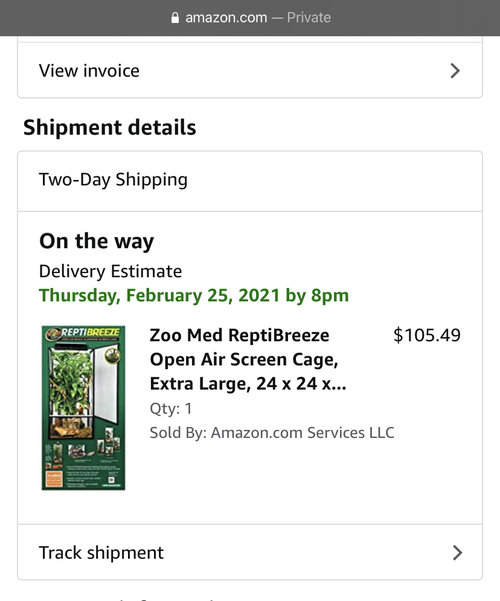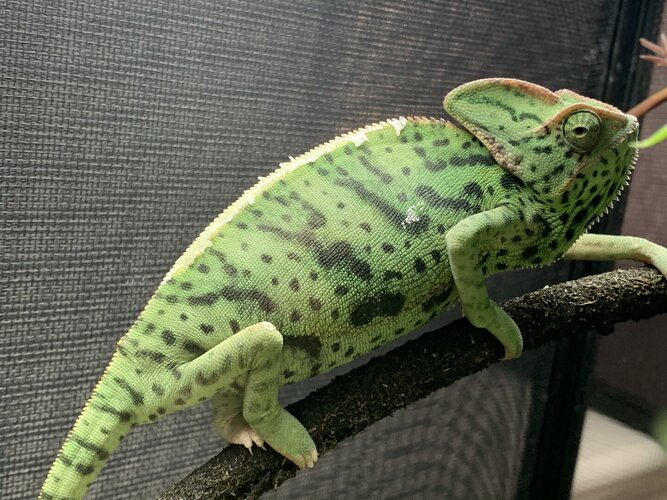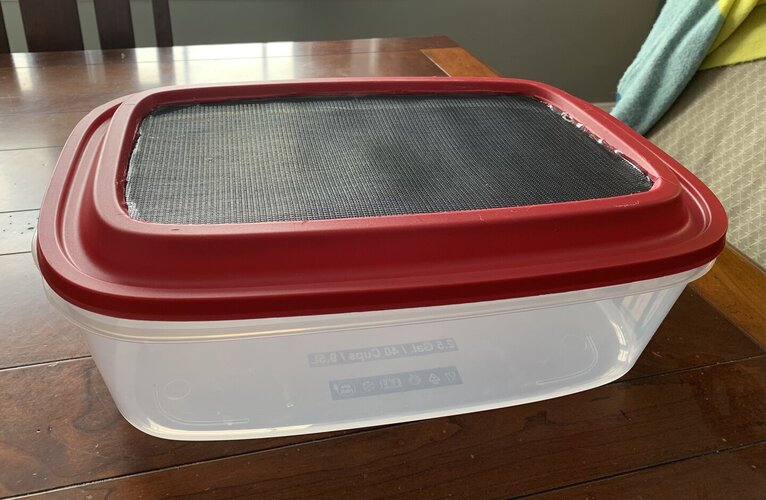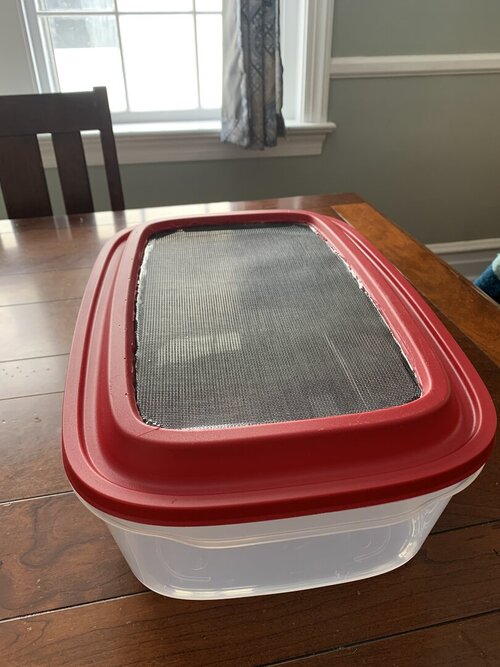Andrew1283
Chameleon Enthusiast
I recently purchased my first chameleon, a juvenile female veiled from a local pet shop. This was not an impulse decision but it was love at first sight. I was purchasing dog food and happened past a glass enclosure with two little googly eyes peeking up at me from under a branch. I asked the store employees a lot of questions before going home to do research and to pass the idea by my wife! These forums have been tremendously helpful because information online is vast but often conflicting. I spent a week researching chameleon habitats (specifically veiled chameleon habitats) before going back to get a screened enclosure named the Reptibreeze Chameleon Kit. It measures 36” tall, 18” wide and 18” long. This size enclosure seems ideal for a juvenile veiled but will need to be upgraded to at least a 48” x 24”x 24” when she reaches adulthood. I chose to use fake plants because they are easier to sanitize and I plan to feed Emmy (her name is short for Emerald) plenty of healthy greens, veggies and some fruits. What’s considered, “healthy” also seems to be up for debate but many people agree some escarole and collard greens are OK along with butternut squash, carrots, tomato, apple, blueberries, and oranges. I plan to keep her fruit intake minimal and only as occasional treats. Since chameleons drink from water droplets I made my own water dripper out of a Pedialyte bottle with a small air line valve stuck into the bottom and some air tubing. I didn’t even have to use silicone to make a seal! Drill a small hole and work the valve in there to make a tight fit. The water line runs through the top screen and drops onto a long leaf of real collard greens. Emmy’s basking spot is at the end of the leaf and she regularly leans in to take a drink from the drips. I used the vines which came with the Chameleon Kit and added some extra thick ones. I gave her plenty of horizontal perching space at multiple levels and put the fake plants up front so she has privacy. When she is hungry and wants to be seen she definitely makes herself known! Hanging the vines is an art, not a science and I had fun with it. The temperature in her basking spot is 92 degrees and the lowest spot in the cage is about 72. I frequently run a humidifier next to her cage because it can get dry (but not cold) in our home during the northeastern winters. I also hand spray several times a day with spring water so her humidity stays at 50-60%. It really hasn’t been a big deal. I also opted for a milled coconut fiber substrate because it helps maintain humidity without staying wet...which can lead to mold and bacterial growth. It makes spot cleaning her poops very easy and sanitary and since it’s cheap, I can replace all the substrate once a month. Another reason for using this substrate is that female chameleons lay eggs and they can become egg bound without a place to dig a nest..which can be fatal. I purchased a compact high output 25 watt basking light which keeps a constant 95 degree temp in her basking spot and I have a high quality T8 UVB bulb so she can get her vitamin D for calcium absorption. I also supplement with Reptivite multivitamin and Repcal with D3 once biweekly. Emmy’s enclosure is right by a window so I keep the cloth curtain shut tight to avoid a draft and I also added an extra layer of thick pet-safe screen on the back of her enclosure to help keep out a draft without eliminating all air movement. I feed her live crickets, half of which I dust with Repcal calcium powder and I shake them up to humanely stun them before placing them on her collard green dipper leaf or from my hand. She can eat 15 medium crickets in a single day! I also use a carrot/potato peeler or a cheese grater to take some shavings of multi colored carrots and butternut squash which I place on her leaf and she enjoys them. I have earned her trust to walk in my hand for crickets and yesterday she took it upon herself to briskly walk up my arm and onto my head. Reaching up to get her I had to wonder if she was going to give my finger a bite but I trusted her and she came down without any stress or issues. Setting up a new enclosure can be as easy or difficult as you want to make it. Keep the health and happiness of your pet at the forefront of your mind and if they choose to trust you there really isn’t anything better than that!
Attachments
-
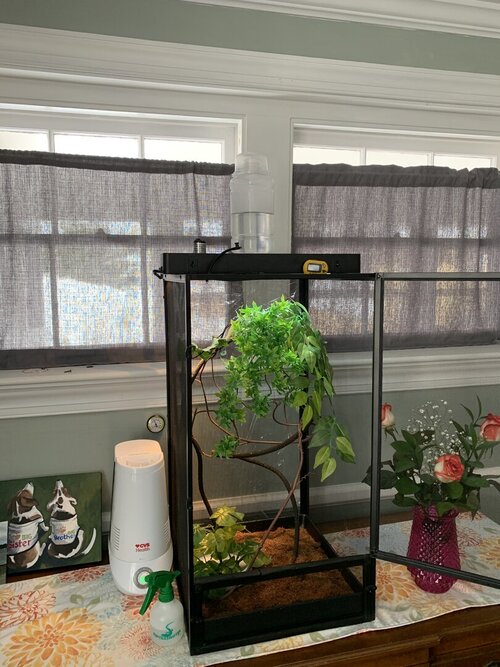 0CF62140-CCDF-4752-B1B6-5C9FDCCAF791.jpeg189.4 KB · Views: 459
0CF62140-CCDF-4752-B1B6-5C9FDCCAF791.jpeg189.4 KB · Views: 459 -
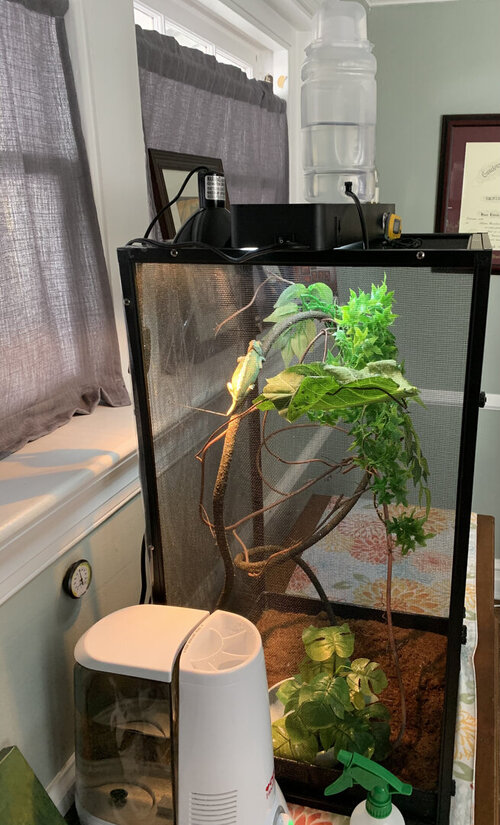 7448628B-4564-4C23-B744-01133224410E.jpeg176.6 KB · Views: 388
7448628B-4564-4C23-B744-01133224410E.jpeg176.6 KB · Views: 388 -
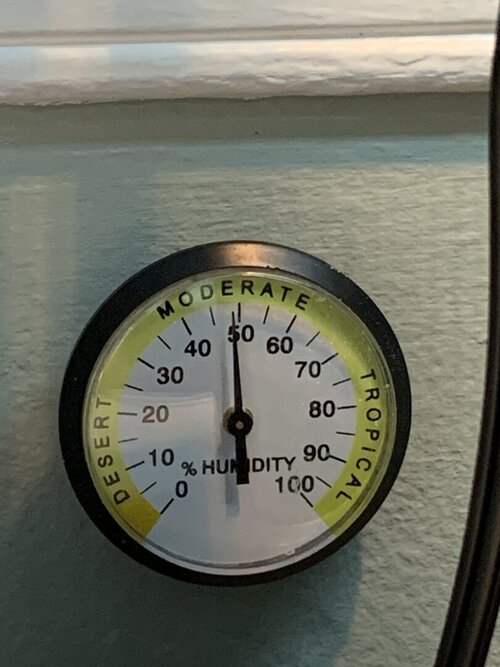 DA22BF1D-EAAB-4567-88B1-BB4440EF6674.jpeg118.1 KB · Views: 363
DA22BF1D-EAAB-4567-88B1-BB4440EF6674.jpeg118.1 KB · Views: 363 -
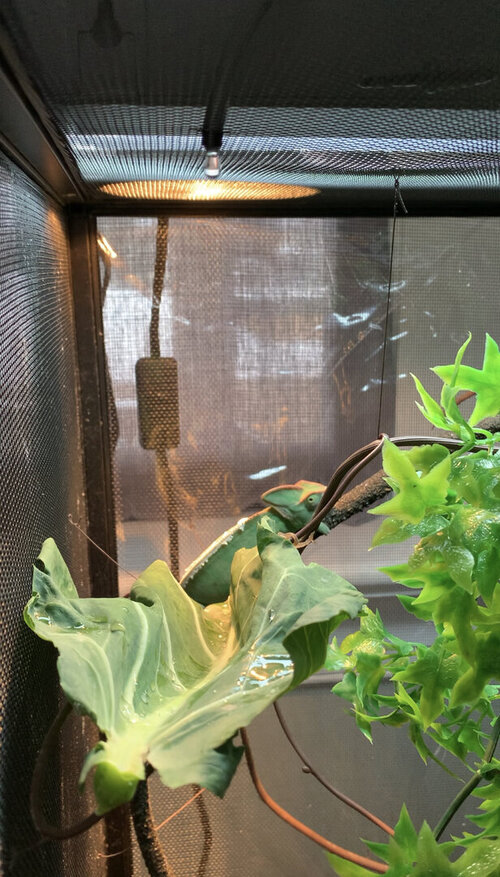 5E2987CA-E51F-4464-A287-1E613280C4E3.jpeg180.9 KB · Views: 325
5E2987CA-E51F-4464-A287-1E613280C4E3.jpeg180.9 KB · Views: 325 -
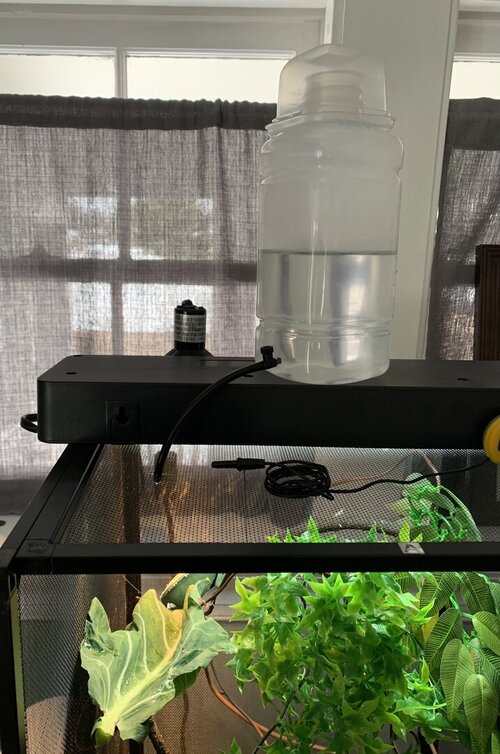 16CBE39F-C456-4EFD-B17A-02FF7A4BC05B.jpeg167.9 KB · Views: 351
16CBE39F-C456-4EFD-B17A-02FF7A4BC05B.jpeg167.9 KB · Views: 351 -
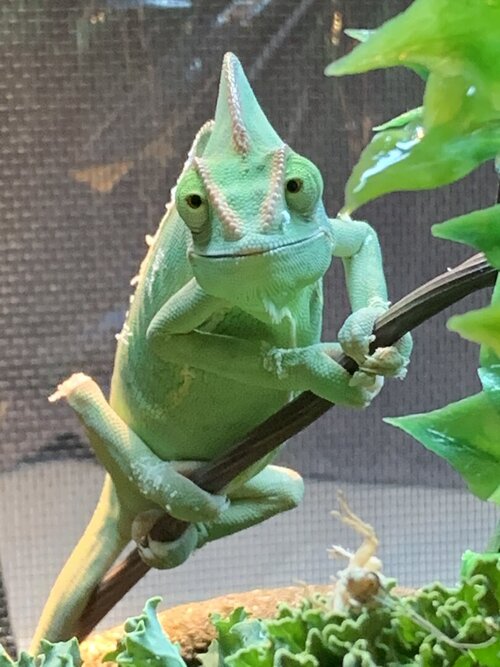 AA00D048-0DC1-4BA2-8F3E-6FB60185F1E1.jpeg146.6 KB · Views: 365
AA00D048-0DC1-4BA2-8F3E-6FB60185F1E1.jpeg146.6 KB · Views: 365 -
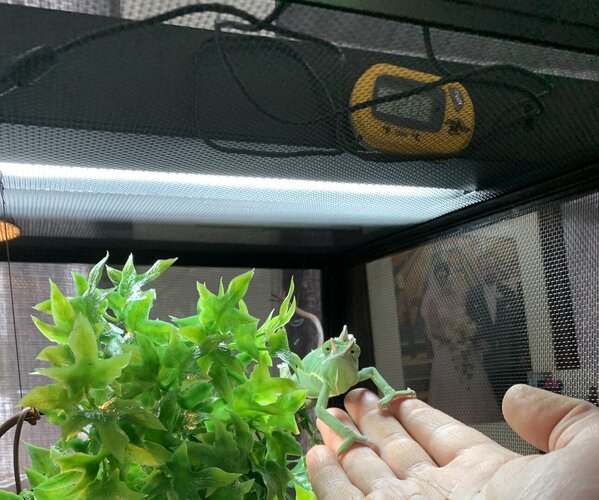 4AC8DCAC-105C-4662-911C-C2997A7F16B2.jpeg292.9 KB · Views: 335
4AC8DCAC-105C-4662-911C-C2997A7F16B2.jpeg292.9 KB · Views: 335 -
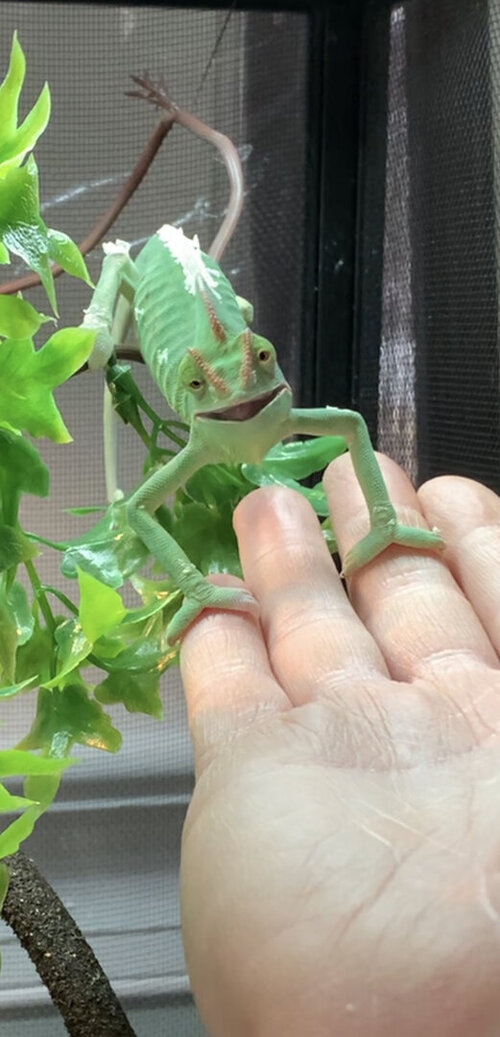 B58C12FA-0235-4815-91B7-8CFD4CC86A61.jpeg103.5 KB · Views: 328
B58C12FA-0235-4815-91B7-8CFD4CC86A61.jpeg103.5 KB · Views: 328 -
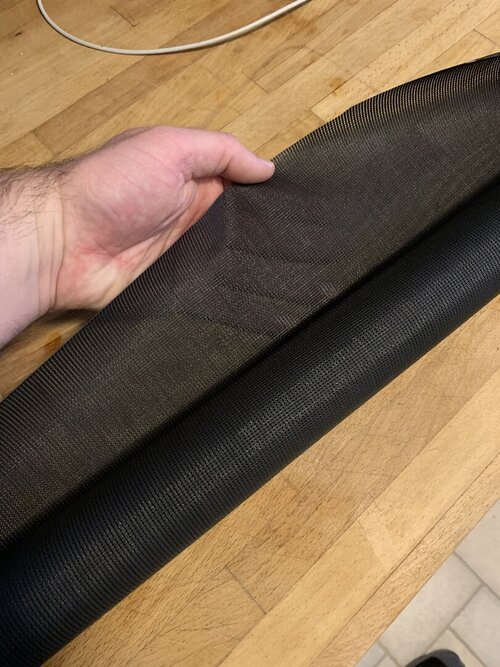 183F86C0-C352-4F99-AAB3-C5ECE1DF1415.jpeg216.2 KB · Views: 329
183F86C0-C352-4F99-AAB3-C5ECE1DF1415.jpeg216.2 KB · Views: 329 -
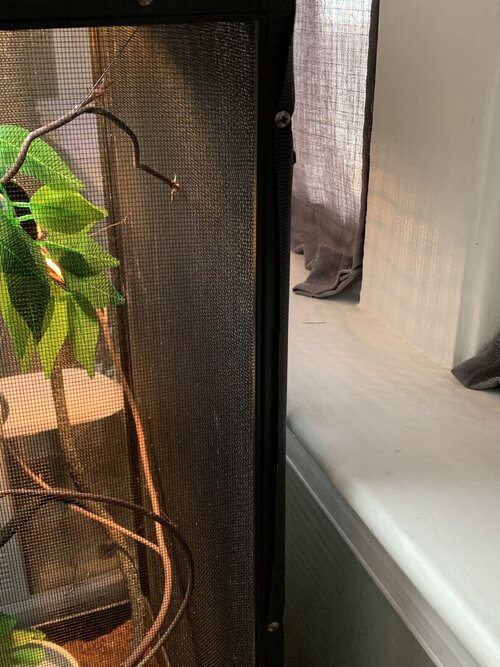 65941649-6585-45F1-96F5-AFC61B080181.jpeg211 KB · Views: 333
65941649-6585-45F1-96F5-AFC61B080181.jpeg211 KB · Views: 333
Last edited:





